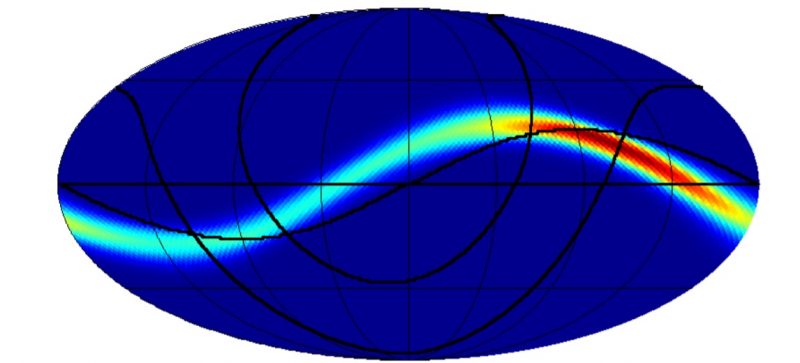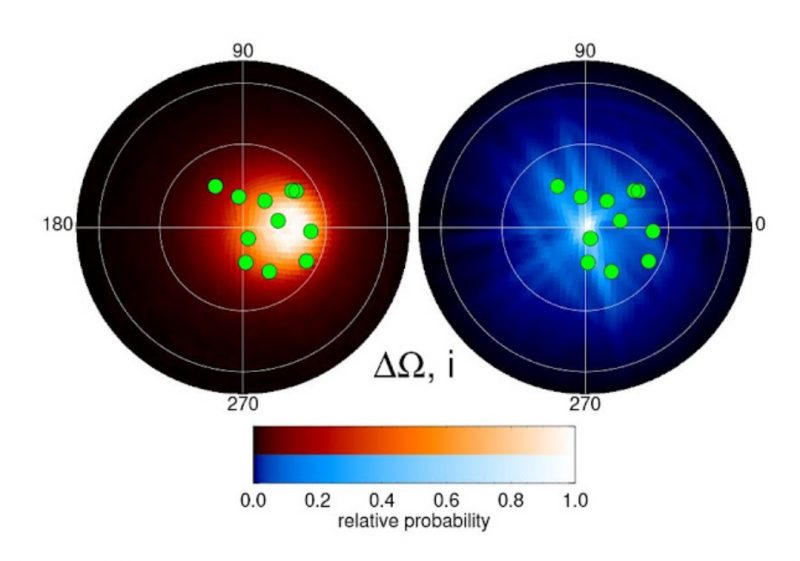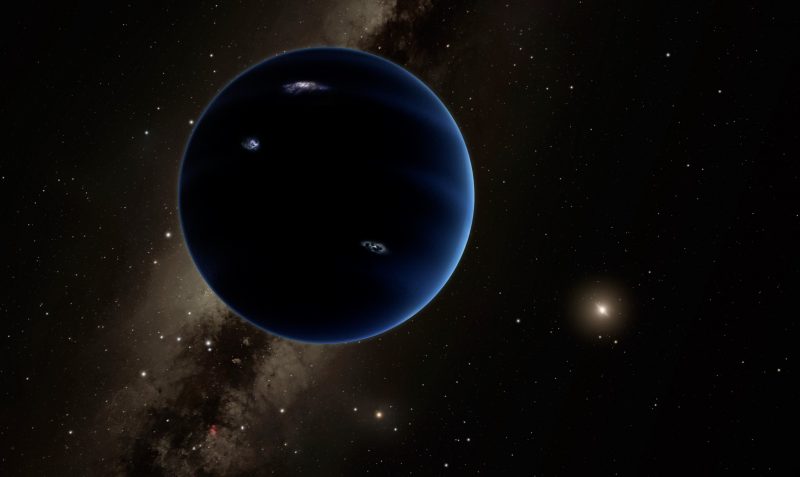
So where is it?
William Herschel discovered Uranus in 1781. Johann Gottried Galle (and others) discovered Neptune in 1846. Clyde Tombaugh discovered Pluto in 1930. Whose name will fill in the blank for the discovery of Planet Nine? Will it be you? Your search just got easier, as last week two scientists provided a map (above) showing the probable orbit of Planet Nine, and its probable location within that orbit.
Mike Brown and Konstantin Batygin, both of Caltech, announced in early 2016 that they had evidence for a Planet Nine – another major planet in our solar system – lurking somewhere in our solar system’s outer realm. And now they’ve produced a map showing where the planet should lie. The peer-reviewed Astronomical Journal accepted their new study on August 22, 2021. A preprint is available on arXiv. Mike Brown’s handle on Twitter is @PlutoKiller. He’s the author of How I Killed Pluto and Why It Had It Coming.
The map shows a wavy line projected on the sky tracing out the most likely path of Planet Nine. But where on that path is Planet Nine right now? As Brown said:
Sadly, the data only tell us the orbital path, not where in the orbital path it is (very sadly, actually). It is more likely to be at its most distant point from the sun, but only because it travels more slowly there. But this is where you should be looking.
The paper [finally!] takes all of the observations of the outer solar system and tries to invert them to learn about the orbit and mass of Planet Nine in a statistically meaningful way. So, where is Planet Nine? Let me show you the treasure map. pic.twitter.com/LijMt7kSWX
— Mike Brown (@plutokiller) August 24, 2021
How they made the map
Brown and Batygin examined the observations of all the known Kuiper Belt Objects with orbits affected by the unknown planet. Kuiper Belt Objects are icy bodies left over from the formation of the solar system that reside in an orbit out past Neptune. Pluto is a Kuiper Belt Object, and so are Eris, Makemake and Haumea. Many of these objects have eccentric orbits that Brown and Batygin believe are being affected by a distant and massive planet: Planet Nine.
Teasing out information from these distant objects took a number of steps. The first step was to separate the tugs of Neptune on the objects from the pull of a more distant planet. The scientists also had to understand the observational bias in these objects (areas that surveys have heavily focused on versus areas that scientists have not examined as closely). They had to create a maximum likelihood model using a combination of numerical simulations and observations of each Kuiper Belt Object. This led them to parameters that show the most probable location for Planet Nine. Voila! We have a treasure map.
Planet Nine: Just the stats
From their calculations taken from Kuiper Belt Objects, the scientists came up with approximate figures for Planet Nine. They estimate Planet Nine to be about 6.2 Earth masses, with an orbit that takes it from 300 astronomical units (AU, with 1 AU being the distance from Earth to the sun) out to 380 AU from the sun. Planet Nine’s orbital inclination, or how much it tilts away from the plane of the solar system, is around 16 degrees. Compare that to Earth’s orbital inclination, which is zero degrees, and Pluto’s, which is 17 degrees.
How bright is Planet Nine?
The brightness of Planet Nine depends on where it’s located in its orbit at the time. The closer the planet is to us in its orbit, the brighter it will be, and vice versa. But the average brightness of Planet Nine should be about magnitude 22. Pluto’s average magnitude is around 15, and it can only be seen by telescopes that are 10 inches or larger.
When a Twitter user asked Brown why we can’t see Planet Nine, Brown answered:
It’s easy to see, but hard to find. It’s like if I show you a grain of sand. No problem seeing it. Now throw it on the beach and try to refind it. Every star in the sky is like a grain of sand in which Planet Nine hides.

Kuiper Belt Objects getting jerked around
The scientists shared the graph above to show how Kuiper Belt Objects are affected by the presence of Planet Nine. The green circles are known Kuiper Belt Objects. The lighter areas of the vertical blue bars are where scientists would expect to find the objects. These are biased locations, because two different surveys have taken more observations in these areas. Thus, this is where we should have spotted more objects. But the objects cluster near the reddish-orange strip in the center, which is where we would find them if something large lurking in the darkness were affecting them.

The round graphs show the objects’ tilt away from the plane of the solar system. A point in the middle would be an object that has the same tilt as the planets. The red graph shows where the Kuiper Belt Objects should be if Planet Nine is tugging on them. The blue graph shows where the Kuiper Belt Objects should be (along the faint crisscrossing lines where the surveys looked for objects) based on observational bias. But the objects don’t align with the blue graph as closely as the red graph. Planet Nine’s tilt is about 16 degrees, and the objects show an average tilt of about 15 degrees.
The clustered objects – instead of being evenly distributed – indicate they’re being influenced by a massive, undiscovered planet. As Mike Brown said on his blog:
Put these two plots together and you get a 99.6% chance that the objects are clustered, rather than uniform. That sounds pretty good to me.

Bottom line: Scientists reveal the orbit of Planet Nine. Now someone just has to look in the right place at the right time and find its dim light hidden among the endless stars.
Join Zooniverse’s citizen science search for Planet Nine











